formerly eScholarship Editions


|
|
|
|
Your request for similar items found 20 book(s). | Modify Search | Displaying 1 - 20 of 20 book(s) | |
| 1. | 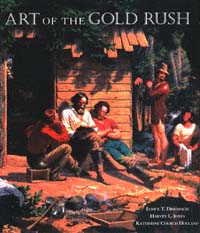 | Title: Art of the gold rush Author: Driesbach, Janice Tolhurst Published: University of California Press, 1998 Subjects: Art | California and the West | Californian and Western History Publisher's Description: The California Gold Rush captured the get-rich dreams of people around the world more completely than almost any event in American history. This catalog, published in celebration of the sesquicentennial of the 1848 discovery of gold at Sutter's Mill, shows the vitality of the arts in the Golden State during the latter nineteenth century and documents the dramatic impact of the Gold Rush on the American imagination.Among the throngs of gold-seekers in California were artists, many self-taught, others formally trained, and their arrival produced an outpouring of artistic works that provide insights into Gold Rush events, personages, and attitudes. The best-known painting of the Gold Rush era, C.C. Nahl's Sunday Morning in the Mines (1872), was created nearly two decades after gold fever had subsided. By then the Gold Rush's mythic qualities were well established, and new allegories - particularly the American belief in the rewards of hard work and enterprise - can be seen on Nahl's canvas. Other works added to the image of California as a destination for ambitious dreamers, an image that prevails to this day. In bringing together a range of art and archival material such as artists' diaries and contemporary newspaper articles, The Art of the Gold Rush broadens our understanding of American culture during a memorable period in the nation's history. [brief] Similar Items |
| 2. | 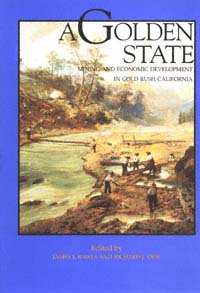 | Title: A golden state: mining and economic development in gold rush California Author: Rawls, James J Published: University of California Press, 1999 Subjects: California and the West | American Studies | Natural History | Geography | Californian and Western History | United States History Publisher's Description: California's storied Gold Rush triggered momentous changes not only for the state, but also for the nation and the world. The economic impact of that epoch-making event is the focus of the second volume of the California History Sesquicentennial Series. The chapter contributors offer a range of perspectives, including commentaries that reflect the new scholarship of environmental and resource history. Together, the essays and more than 90 illustrations show how the Gold Rush precipitated a veritable economic revolution whose effects continue to this day.Among the topics given a fresh interpretation are the relationship between technology and society; the environmental impact from mining and the sudden increase in California's population; the influence of the Gold Rush on agriculture, manufacturing, banking, and transportation; and its impact on the peoples and economies of Latin America, Europe, and Asia. The popular image of the independent prospector is also examined anew, as is the role of different groups of industrial workers, including Chinese, Mexicans, and women.The Gold Rush was a multiplier, an event that accelerated a chain of interrelated consequences that in turn accelerated economic growth. But it also touched a deep-seated nerve in the human psyche and unleashed economic forces, for good or ill, that transformed California forever into a Golden State. [brief] Similar Items |
| 3. | 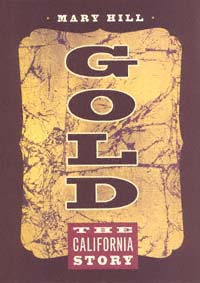 | Title: Gold: the California story Author: Hill, Mary 1923- Published: University of California Press, 2000 Subjects: California and the West | Californian and Western History | Geology | Natural History Publisher's Description: The discovery of gold in 1848 catapulted California into statehood and triggered environmental, social, political, and economic events whose repercussions are still felt today. Mary Hill combines her scientific training with a flair for storytelling to present the history of gold in California from the distant geological past through the wild days of the Gold Rush to the present.The early days of gold fever drew would-be miners from around the world, many enduring great hardships to reach California. Once here, they found mining to be backbreaking work and devised machines to help recover gold. These machines pawed gravel from river bottoms and tore apart mountainsides, wreaking environmental havoc that silted rivers, ruined farmlands, and provoked the world's first environmental conflict settled in the courts. Native Americans were nearly wiped out by invading miners or their diseases, and many Spanish-speaking settlers - Californios - were pushed aside.Hill writes of gold's uses in today's world for everything from coins to coffins, gourmet foods to spacecraft. Her comprehensive overview of gold's impact on California includes illustrated explanations of geology and mining in nontechnical language as well as numerous illustrations, maps, and photographs. [brief] Similar Items |
| 4. |  | Title: Contested Eden: California before the Gold Rush Author: Gutiérrez, Ramón A 1951- Published: University of California Press, 1998 Subjects: History | California and the West | Californian and Western History | United States History | Native American Ethnicity | Environmental Studies | Natural History | American Studies Publisher's Description: Celebrating the 150th birthday of the state of California offers the opportunity to reexamine the founding of modern California, from the earliest days through the Gold Rush and up to 1870. In this four-volume series, published in association with the California Historical Society, leading scholars offer a contemporary perspective on such issues as the evolution of a distinctive California culture, the interaction between people and the natural environment, the ways in which California's development affected the United States and the world, and the legacy of cultural and ethnic diversity in the state. California before the Gold Rush , the first California Sesquicentennial volume, combines topics of interest to scholars and general readers alike. The essays investigate traditional historical subjects and also explore such areas as environmental science, women's history, and Indian history. Authored by distinguished scholars in their respective fields, each essay contains excellent summary bibliographies of leading works on pertinent topics. This volume also features an extraordinary full-color photographic essay on the artistic record of the conquest of California by Europeans, as well as over seventy black-and-white photographs, some never before published. [brief] Similar Items |
| 5. | 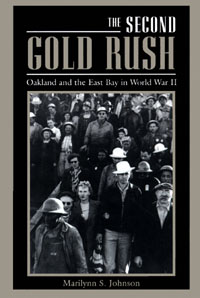 | Title: The second gold rush: Oakland and the East Bay in World War II Author: Johnson, Marilynn S Published: University of California Press, 1994 Subjects: History | Urban Studies | Californian and Western History | American Studies | California and the West | Ethnic Studies Publisher's Description: More than any event in the twentieth century, World War II marked the coming of age of America's West Coast cities. Almost overnight, new war industries prompted the mass urban migration and development that would trigger lasting social, cultural, and political changes. For the San Francisco Bay Area, argues Marilynn Johnson, the changes brought by World War II were as dramatic as those brought by the gold rush a century earlier.Focusing on Oakland, Richmond, and other East Bay shipyard boomtowns, Johnson chronicles the defense buildup, labor migration from the South and Midwest, housing issues, and social and racial conflicts that pitted newcomers against longtime Bay Area residents. She follows this story into the postwar era, when struggles over employment, housing, and civil rights shaped the urban political landscape for the 1950s and beyond. She also traces the cultural legacy of war migration and shows how Southern religion and music became an integral part of Bay Area culture.Johnson's sources are wide-ranging and include shipyard records, labor histories, police reports, and interviews. Her findings place the war's human drama at center stage and effectively recreate the texture of daily life in workplace, home, and community. Enriched by the photographs of Dorothea Lange and others, The Second Gold Rush makes an important contribution to twentieth-century urban studies as well as to California history. [brief] Similar Items |
| 6. | 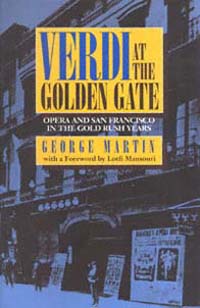 | Title: Verdi at the Golden Gate: opera and San Francisco in the Gold Rush years Author: Martin, George Whitney Published: University of California Press, 1993 Subjects: Music | History | Opera | Composers | American Studies | California and the West | European History Publisher's Description: Opera is a fragile, complex art, but it flourished extravagantly in San Francisco during the Gold Rush years, a time when daily life in the city was filled with gambling, duels, murder, and suicide. In the history of the United States there has never been a rougher town than Gold Rush San Francisco, yet there has never been a greater frenzy for opera than developed there in these exciting years.How did this madness for opera take root and grow? Why did the audience's generally drunken, brawling behavior gradually improve? How and why did Verdi emerge as the city's favorite composer? These are the intriguing themes of George Martin's enlightening and wonderfully entertaining story. Among the incidents recounted are the fist fight that stopped an opera performance and ended in a fatal duel; and the brothel madam who, by sitting in the wrong row of a theater, caused a fracas that resulted in the formation of the Vigilantes of 1856.Martin weaves together meticulously gathered social, political, and musical facts to create this lively cultural history. His study contributes to a new understanding of urban culture in the Jacksonian?Manifest Destiny eras, and of the role of opera in cities during this time, especially in the American West. Over it all soars Verdi's somber, romantic music, capturing the melancholy, the feverish joy, and the idealism of his listeners. [brief] Similar Items |
| 7. | 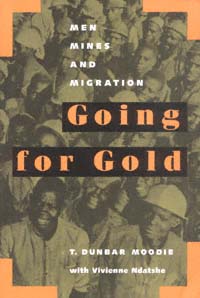 | Title: Going for gold: men, mines, and migration Author: Moodie, T. Dunbar Published: University of California Press, 1994 Subjects: Sociology | African Studies | Social Theory | Men and Masculinity Publisher's Description: This book tells the story of the lives of migrant black African men who work on the South African gold mines, told from their own point of view and, as much as possible, in their own words. Dunbar Moodie examines the operation of local power structures and resistances, changes in production techniques, the limits and successes of unionization, and the nature of ethnic conflicts at different periods and on different terrains of struggle. He treats his subject thematically and historically, examining how notions of integrity, manhood, sexuality, work, power, solidarity, and violence have all changed over time, especially with the shift to a proletarianized work force on the mines in the 1970s. Moodie integrates analyses of individual life-strategies with theories of social change, illuminating the ways in which these play off each other in historically significant ways. He shows how human beings (in this case, African men) build integrity and construct their own social order, even in situations of apparent total repression. [brief] Similar Items |
| 8. | 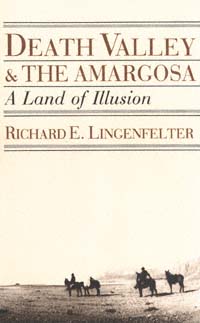 | Title: Death Valley & the Amargosa: a land of illusion Author: Lingenfelter, Richard E Published: University of California Press, 1988 Subjects: History | California and the West | United States History Similar Items |
| 9. | 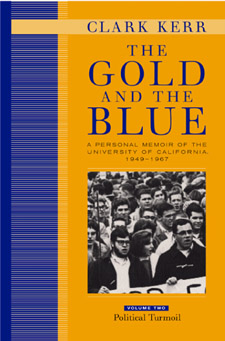 | Title: The gold and the blue: a personal memoir of the University of California, 1949-1967 Author: Kerr, Clark 1911- Published: University of California Press, 2003 Subjects: Autobiographies and Biographies | California and the West | History | Intellectual History Publisher's Description: The Los Angeles Times called the first volume of The Gold and the Blue "a major contribution to our understanding of American research universities." This second of two volumes continues the story of one of the last century's most influential figures in higher education. A leading visionary, architect, leader, and fighter for the University of California, Clark Kerr was chancellor of the Berkeley campus from 1952 to 1958 and president of the university from 1958 to 1967. He saw the university through its golden years - a time of both great advancement and great conflict. This absorbing memoir is an intriguing insider's account of how the University of California rose to the peak of scientific and scholarly stature and how, under Kerr's unique leadership, it evolved into the institution it is today. In Volume II: Political Turmoil, Kerr turns to the external and political environment of the 1950s and 1960s, contrasting the meteoric rise of the University of California to the highest pinnacle of academic achievement with its troubled political context. He describes his attempts to steer a middle course between attacks from the political Right and Left and discusses the continuing attacks on the university, and on him personally, by the state Un-American Activities Committee. He provides a unique point of view of the Free Speech Movement on the Berkeley campus in the fall of 1964. He also details the events of January 1967, when he was dismissed as president of the university by the Board of Regents. [brief] Similar Items |
| 10. | 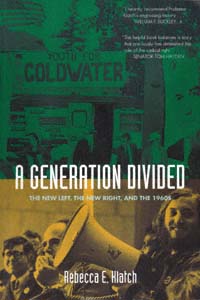 | Title: A generation divided: the new left, the new right, and the 1960s Author: Klatch, Rebecca E Published: University of California Press, 1999 Subjects: Sociology | American Studies | Politics Publisher's Description: The 1960s was not just an era of civil rights, anti-war protest, women's liberation, hippies, marijuana, and rock festivals. The untold story of the 1960s is in fact about the New Right. For young conservatives the decade was about Barry Goldwater, Ayn Rand, an important war in the fight against communism, and Young Americans for Freedom (YAF). In A Generation Divided , Rebecca Klatch examines the generation that came into political consciousness during the 1960s, telling the story of both the New Right and the New Left, and including the voices of women as well as men. The result is a riveting narrative of an extraordinary decade, of how politics became central to the identities of a generation of people, and how changes in the political landscape of the 1980s and 1990s affected this identity. [brief] Similar Items |
| 11. | 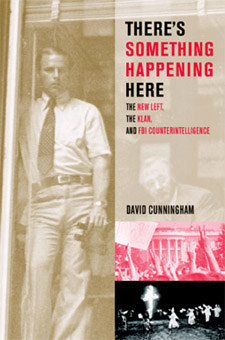 | Title: There's something happening here: the New Left, the Klan, and FBI counterintelligence Author: Cunningham, David 1970- Published: University of California Press, 2004 Subjects: American Studies | History | Politics | Sociology | Law Publisher's Description: Using over twelve thousand previously classified documents made available through the Freedom of Information Act, David Cunningham uncovers the riveting inside story of the FBI's attempts to neutralize political targets on both the Right and the Left during the 1960s. Examining the FBI's infamous counterintelligence programs (COINTELPROs) against suspected communists, civil rights and black power advocates, Klan adherents, and antiwar activists, he questions whether such actions were aberrations or are evidence of the bureau's ongoing mission to restrict citizens' right to engage in legal forms of political dissent. At a time of heightened concerns about domestic security, with the FBI's license to spy on U.S. citizens expanded to a historic degree, the question becomes an urgent one. This book supplies readers with insights and information vital to a meaningful assessment of the current situation. There's Something Happening Here looks inside the FBI's COINTELPROs against white hate groups and the New Left to explore how agents dealt with the hundreds of individuals and organizations labeled as subversive threats. Rather than reducing these activities to a product of the idiosyncratic concerns of longtime director J. Edgar Hoover, Cunningham focuses on the complex organizational dynamics that generated literally thousands of COINTELPRO actions. His account shows how--and why--the inner workings of the programs led to outcomes that often seemed to lack any overriding logic; it also examines the impact the bureau's massive campaign of repression had on its targets. The lessons of this era have considerable relevance today, and Cunningham extends his analysis to the FBI's often controversial recent actions to map the influence of the COINTELPRO legacy on contemporary debates over national security and civil liberties. [brief] Similar Items |
| 12. | 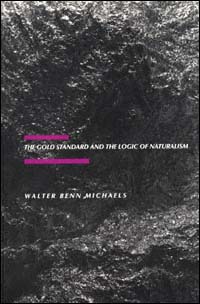 | Title: The gold standard and the logic of naturalism: American literature at the turn of the century Author: Michaels, Walter Benn Published: University of California Press, 1987 Subjects: Literature | American Literature Publisher's Description: The Gold Standard and the Logic of Naturalism discusses ways of creating value in turn-of-the-century American capitalism. Focusing on such topics as the alienation of property, the invention of masochism, and the battle over free silver, it examines the participation of cultural forms in these phenomena. It imagines a literary history that must at the same time be social, economic, and legal; and it imagines a literature that, to be understood at all, must be understood both as a producer and a product of market capitalism. [brief] Similar Items |
| 13. | 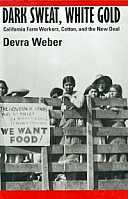 | Title: Dark sweat, white gold: California farm workers, cotton, and the New Deal Author: Weber, Devra 1946- Published: University of California Press, 1994 Subjects: History | Californian and Western History | Latino Studies | Labor Studies | California and the West | African History Publisher's Description: In her incisive analysis of the shaping of California's agricultural work force, Devra Weber shows how the cultural background of Mexican and, later, Anglo-American workers, combined with the structure of capitalist cotton production and New Deal politics, forging a new form of labor relations. She pays particular attention to Mexican field workers and their organized struggles, including the famous strikes of 1933.Weber's perceptive examination of the relationships between economic structure, human agency, and the state, as well as her discussions of the crucial role of women in both Mexican and Anglo working-class life, make her book a valuable contribution to labor, agriculture, Chicano, Mexican, and California history. [brief] Similar Items |
| 14. | 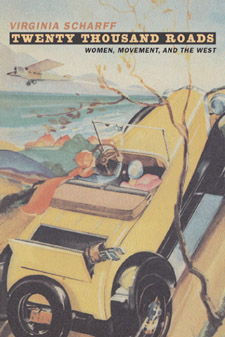 | Title: Twenty thousand roads: women, movement, and the West Author: Scharff, Virginia Published: University of California Press, 2002 Subjects: History | Women's Studies | California and the West Publisher's Description: From Sacagawea's travels with Lewis and Clark to rock groupie Pamela Des Barres's California trips, women have moved across the American West with profound consequences for the people and places they encounter. Virginia Scharff revisits a grand theme of United States history - our restless, relentless westward movement--but sets out in new directions, following women's trails from the early nineteenth to the late twentieth centuries. In colorful, spirited stories, she weaves a lyrical reconsideration of the processes that created, gave meaning to, and ultimately shattered the West. Twenty Thousand Roads introduces a cast of women mapping the world on their own terms, often crossing political and cultural boundaries defined by male-dominated institutions and perceptions. Scharff examines the faint traces left by Sacagawea and revisits Susan Magoffin's famed honeymoon journey down the Santa Fe Trail. We also meet educated women like historian Grace Hebard and government extension agent Fabiola Cabeza de Baca, who mapped the West with different voyages and visions. Scharff introduces women whose lives gave shape to the forces of gender, race, region, and modernity; participants in exploration, war, politics, empire, and struggles for social justice; and movers and shakers of everyday family life. This book powerfully and poetically shows us that to understand the American West, we must examine the lives of women who both built and resisted American expansion. Scharff remaps western history as she reveals how moving women have shaped our past, present, and future. [brief] Similar Items |
| 15. | 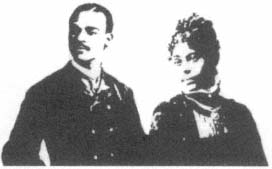 | Title: Pioneer urbanites: a social and cultural history of Black San Francisco Author: Daniels, Douglas Henry Published: University of California Press, 1991 Subjects: American Studies | African American Studies | Social Problems | California and the West | United States History Publisher's Description: The black migration to San Francisco and the Bay Area differed from the mass movement of Southern rural blacks and their families into the eastern industrial cities. Those who traveled West, or arrived by ship, were often independent, sophisticated, single men. Many were associated with the transportation boom following the Gold Rush; others traveled as employees of wealthy individuals.Douglas Daniels argues for the importance of going beyond the written record and urban statistics in examining the life of a minority community. He has studied photographs from family albums and interviewed members of old black San Francisco families in his effort to provide the first nuanced picture of the lives of black San Franciscans from the 1860s to the 1940s. [brief] Similar Items |
| 16. | 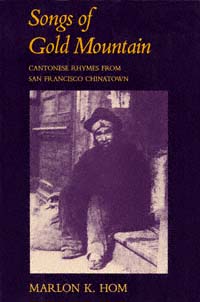 | Title: Songs of Gold Mountain: Cantonese rhymes from San Francisco Chinatown Author: Hom, Marlon K Published: University of California Press, 1992 Subjects: Ethnic Studies | Asian American Studies | American Literature | Folklore and Mythology Publisher's Description: Marlon Hom has selected and translated 220 rhymes from two collections of Chinatown songs published in 1911 and 1915. The songs are outspoken and personal, addressing subjects as diverse as sex, frustrations with the American bureaucracy, poverty and alienation, and the loose morals of the younger g . . . [more] Similar Items |
| 17. | 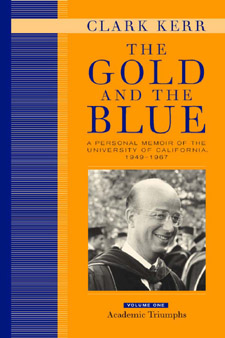 | Title: The gold and the blue: a personal memoir of the University of California, 1949-1967 Author: Kerr, Clark 1911- Published: University of California Press, 2001 Subjects: History | California and the West | Intellectual History | Californian and Western History | Autobiography Publisher's Description: One of the last century's most influential figures in higher education, Clark Kerr was a leading visionary, architect, leader, and fighter for the University of California. Chancellor of the Berkeley campus from 1952 to 1958 and president of the university from 1958 to 1967, Kerr saw the university through its golden years--a time of both great advancement and great conflict. This absorbing memoir is an intriguing insider's account of how the University of California rose to the peak of scientific and scholarly stature and how, under Kerr's unique leadership, the university evolved into the institution it is today. In this first of two volumes, Kerr describes the private life of the university from his first visit to Berkeley as a graduate student at Stanford in 1932 to his dismissal under Governor Ronald Reagan in 1967. Early in his tenure as a professor, the Loyalty Oath issue erupted, and the university, particularly the Berkeley campus, underwent its most difficult upheaval until the onset of the Free Speech Movement in 1964. Kerr discusses many pivotal developments, including the impact of the GI Bill and the evolution of the much-emulated 1960 California Master Plan for Higher Education. He also discusses the movement for universal access to education and describes the establishment and growth of each of the nine campuses and the forces and visions that shaped their distinctive identities. Kerr's perspective of more than fifty years puts him in a unique position to assess which of the academic, structural, and student life innovations of the 1950s and 1960s have proven successful and to consider what lessons about higher education we might learn from that period. The second volume of the memoir will treat the public life of the university and the political context that conditioned its environment. [brief] Similar Items |
| 18. | 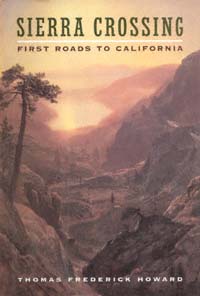 | Title: Sierra crossing: first roads to California Author: Howard, Thomas Frederick 1946- Published: University of California Press, 1998 Subjects: California and the West | Californian and Western History | Geography | United States History Publisher's Description: A critical era in California's history and development - the building of the first roads over the Sierra Nevada - is thoroughly and colorfully documented in Thomas Howard's fascinating book. During California's first two decades of statehood (1850-1870), the state was separated from the east coast by a sea journey of at least six weeks. Although Californians expected to be connected with the other states by railroad soon after the 1849 Gold Rush, almost twenty years elapsed before this occurred. Meanwhile, various overland road ventures were launched by "emigrants," former gold miners, state government officials, the War Department, the Interior Department, local politicians, town businessmen, stagecoach operators, and other entrepreneurs whose alliances with one another were constantly shifting. The broad landscape of international affairs is also a part of Howard's story.Constructing roads and accumulating geographic information in the Sierra Nevada reflected Washington's interest in securing the vast western territories formerly held by others. In a remarkably short time the Sierra was transformed by vigorous exploration, road-promotion, and road-building. Ox-drawn wagons gave way to stagecoaches able to provide service as fine as any in the country. Howard effectively uses diaries, letters, newspaper stories, and official reports to recreate the human struggle and excitement involved in building the first trans-Sierra roads. Some of those roads have become modern highways used by thousands every day, while others are now only dim traces in the lonely backcountry. [brief] Similar Items |
| 19. | 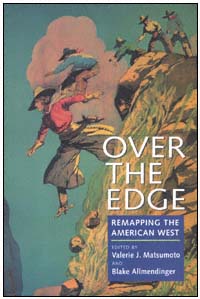 | Title: Over the edge: remapping the American West Author: Matsumoto, Valerie J Published: University of California Press, 1999 Subjects: American Studies | California and the West | Popular Culture | History | United States History | Californian and Western History | German Studies Publisher's Description: From the Gold Rush to rush hour, the history of the American West is fraught with diverse, subversive, and at times downright eccentric elements. This provocative volume challenges traditional readings of western history and literature, and redraws the boundaries of the American West with absorbing essays ranging widely on topics from tourism to immigration, from environmental battles to interethnic relations, and from law to film. Taken together, the essays reassess the contributions of a diverse and multicultural America to the West, as they link western issues to global frontiers.Featuring the latest work by some of the best new writers both inside and outside academia, the original essays in Over the Edge confront the traditional field of western American studies with a series of radical, speculative, and sometimes outrageous challenges. The collection reads the West through Ben-Hur and the films of Mae West; revises the western American literary canon to include the works of African American and Mexican American writers; examines the implications of miscegenation law and American Indian blood quantum requirements; and brings attention to the historical participation of Mexican and Japanese American women, Native American slaves, and Alaskan cannery workers in community life. [brief] Similar Items |
| 20. | 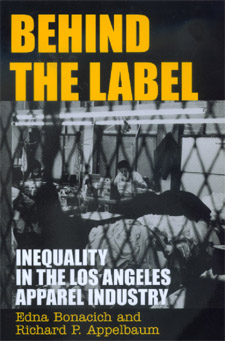 | Title: Behind the label: inequality in the Los Angeles apparel industry Author: Bonacich, Edna Published: University of California Press, 2000 Subjects: Sociology | Social Problems | California and the West | Labor Studies | Economics and Business | Urban Studies | American Studies | Ethnic Studies Publisher's Description: In a study crucial to our understanding of American social inequality, Edna Bonacich and Richard Appelbaum investigate the return of sweatshops to the apparel industry, especially in Los Angeles. The "new" sweatshops, they say, need to be understood in terms of the decline in the American welfare state and its strong unions and the rise in global and flexible production. Apparel manufacturers now have the incentive to move production to wherever low-wage labor can be found, while maintaining arm's-length contractual relations that protect them from responsibility. The flight of the industry has led to a huge rise in apparel imports to the United States and to a decline in employment. Los Angeles, however, remains a puzzling exception in that its industry employment has continued to grow, to the point where L.A. is the largest center of apparel production in the nation. Not only the availability of low-wage immigrant (often undocumented) workers but also the focus on moderately priced, fashion-sensitive women's wear makes this possible. Behind the Label examines the players in the L.A. apparel industry, including manufacturers, retailers, contractors, and workers, evaluating the maldistribution of wealth and power. The authors explore government and union efforts to eradicate sweatshops while limiting the flight to Mexico and elsewhere, and they conclude with a description of the growing antisweatshop movement. Los Angeles Times Best Nonfiction Book of 2000 [brief] Similar Items |